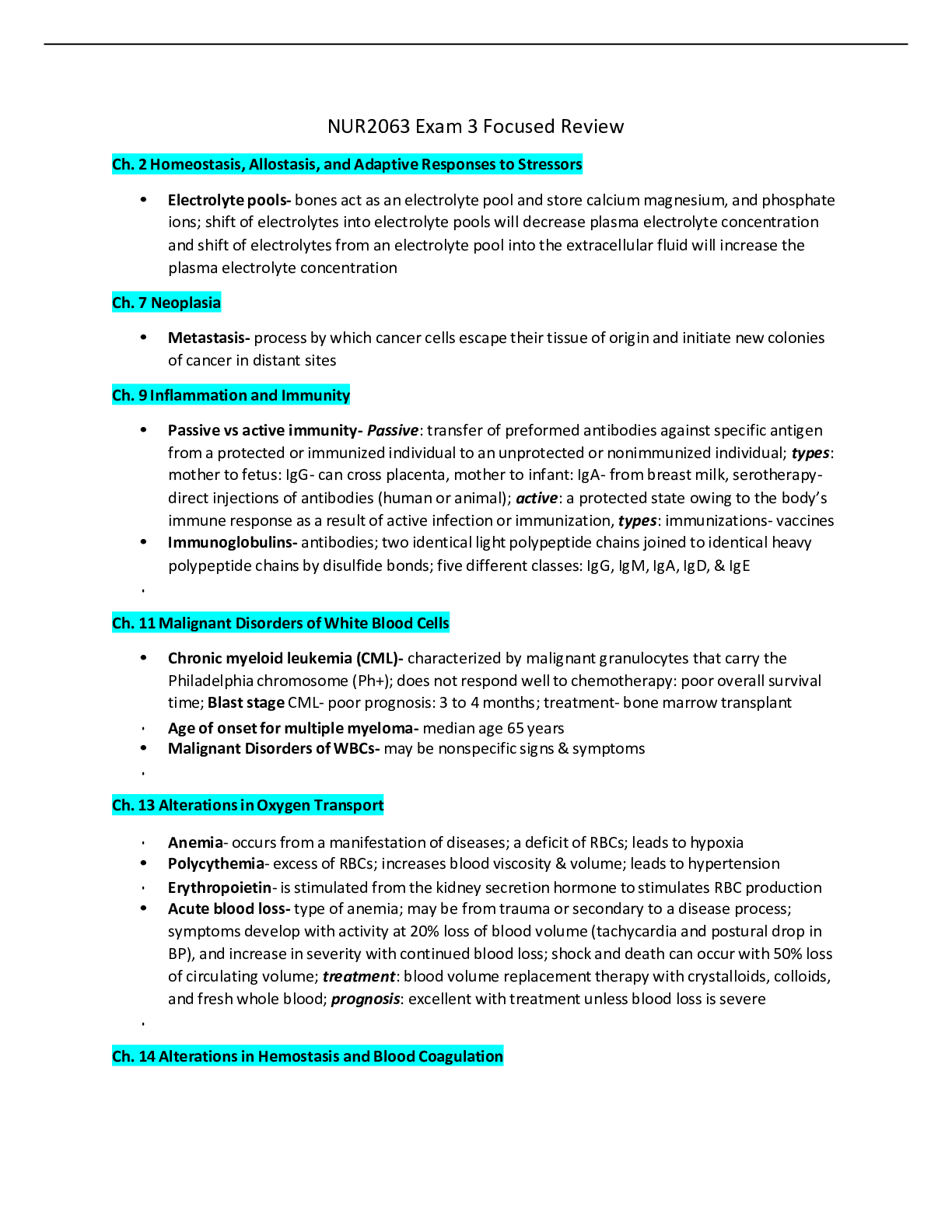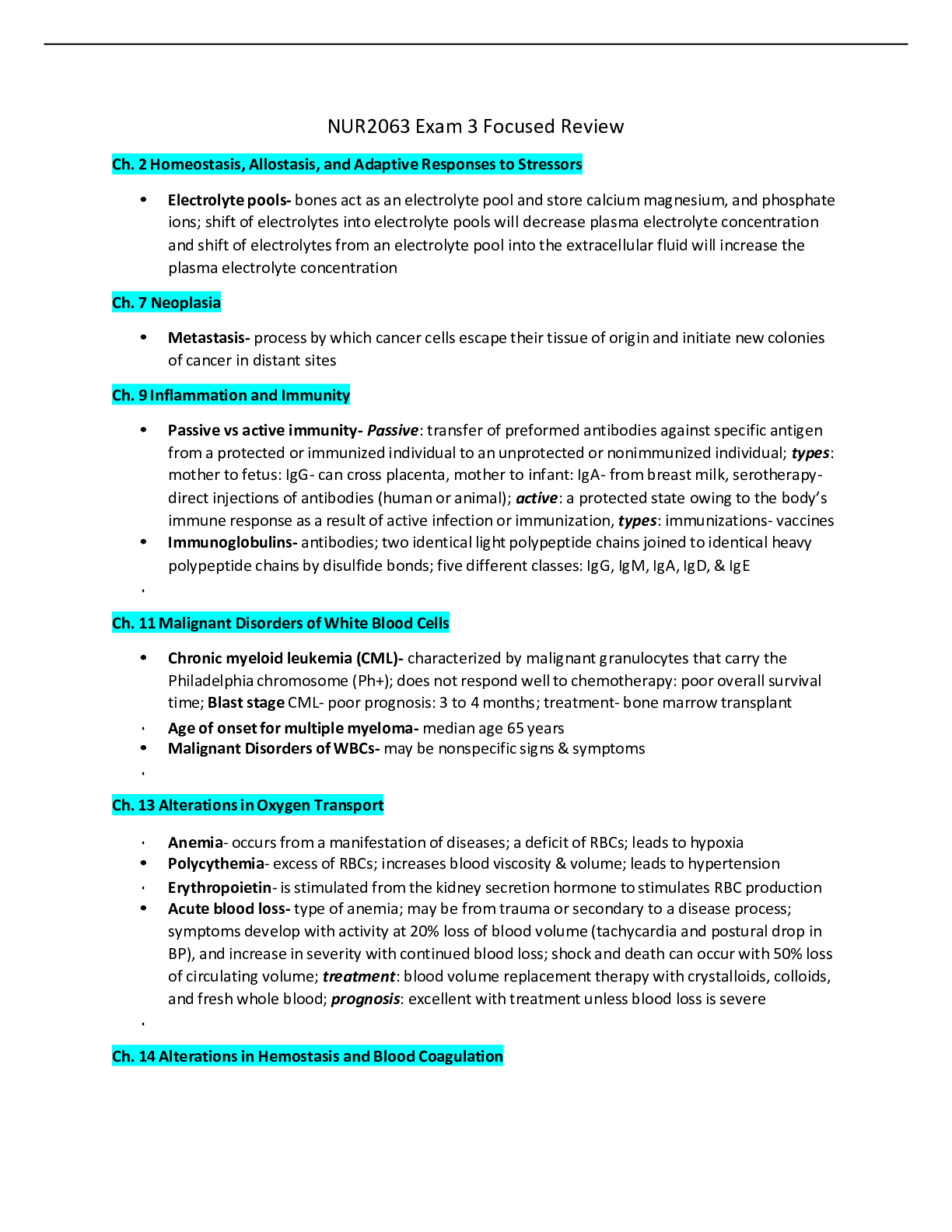Ch. 2 Homeostasis, Allostasis, and Adaptive Responsesto Stressors
• Electrolyte pools- bones act as an electrolyte pool and store calcium magnesium, and phosphate
ions; shift of electrolytes into electrolyte pools will decrease plasma electrolyte concentration
and shift of electrolytes from an electrolyte pool into the extracellular fluid will increase the
plasma electrolyte concentration
Ch. 7 Neoplasia
• Metastasis- process by which cancer cells escape their tissue of origin and initiate new colonies
of cancer in distant sites
Ch. 9 Inflammation and Immunity
• Passive vs active immunity- Passive: transfer of preformed antibodies against specific antigen
from a protected or immunized individual to an unprotected or nonimmunized individual; types:
mother to fetus: IgG- can cross placenta, mother to infant: IgA- from breast milk, serotherapydirect injections of antibodies (human or animal); active: a protected state owing to the body’s
immune response as a result of active infection or immunization, types: immunizations- vaccines
• Immunoglobulins- antibodies; two identical light polypeptide chains joined to identical heavy
polypeptide chains by disulfide bonds; five different classes: IgG, IgM, IgA, IgD, & IgE
•
Ch. 11 Malignant Disorders of White Blood Cells
• Chronic myeloid leukemia (CML)- characterized by malignant granulocytes that carry the
Philadelphia chromosome (Ph+); does not respond well to chemotherapy: poor overall survival
time; Blaststage CML- poor prognosis: 3 to 4 months; treatment- bone marrow transplant
• Age of onset for multiple myeloma- median age 65 years
• Malignant Disorders of WBCs- may be nonspecific signs & symptoms
•
Ch. 13 Alterationsin Oxygen Transport
• Anemia- occurs from a manifestation of diseases; a deficit of RBCs; leads to hypoxia
• Polycythemia- excess of RBCs; increases blood viscosity & volume; leadsto hypertension
• Erythropoietin- is stimulated from the kidney secretion hormone to stimulates RBC production
• Acute blood loss- type of anemia; may be from trauma or secondary to a disease process;
symptoms develop with activity at 20% loss of blood volume (tachycardia and postural drop in
BP), and increase in severity with continued blood loss;shock and death can occur with 50% loss
of circulating volume; treatment: blood volume replacement therapy with crystalloids, colloids,
and fresh whole blood; prognosis: excellent with treatment unless blood loss is severe
•
Ch. 14 Alterationsin Hemostasis and Blood Coagulation
• Thrombocytopenia causes- 1) bone marrow suppression from chemotherapy, 2) recent
immunizations, 3) alcohol ingestion, 4) decreased platelet production, 5) decreased platelet
survival, 6) splenic sequestration, & 7) intravascular dilution of circulating platelets from
transfusion
• DIC (Disseminated Intravascular Coagulation)- acquired hemorrhagic syndrome in which
clotting, and bleeding occur simultaneously. Widespread clot formation in small vessels; clotting
and platelets consumed resulting in bleeding. Causes: trauma, malignancy, burns, shock, and
abruptio placentae. Clinical manifestations: fibrinogen level and platelet count decreased,
increased bleeding time, elevated PT/INR/aPTT, elevated D-dimer/fibrin split products.
Treatment: Removal/correction of underlying cause,support major organs, fresh frozen plasma,
packed red blood cells, platelets, or cryoprecipitate, heparin used to minimize further
consumption of clotting factors (controversial).
•
Ch. 15 Alterationsin Blood Flow
• Atherosclerosisis the leading cause of coronary artery/heart disease
Ch. 16 Alterationsin Blood Pressure
• Treatment of hypertension- (lifestyle modifications) weight loss, exercise, DASH diet, alcohol
moderation, decreased sodium intake; drug therapy affects HR, SVR, and/or stroke volume
• Long term problems from hypertension- Renal failure,stroke, heart disease, Damage to arterial
system and acceleration of atherosclerosis lead to cardiovascular disease, Increased myocardial
work results in heart failure, Glomerular damage results in kidney failure, Affects
microcirculation of the eyes, Increased pressure in cerebral vasculature can result in hemorrhage
• Modifiable vs nonmodifiable risk factors for hypertension- modifiable: dietary factors,
sedentary lifestyle, obesity/weight gain, metabolic syndrome, elevated blood glucose
levels/diabetes, elevated total cholesterol, alcohol &smoking; nonmodifiable: family history,
age, ethnicity/genetics
Read More


